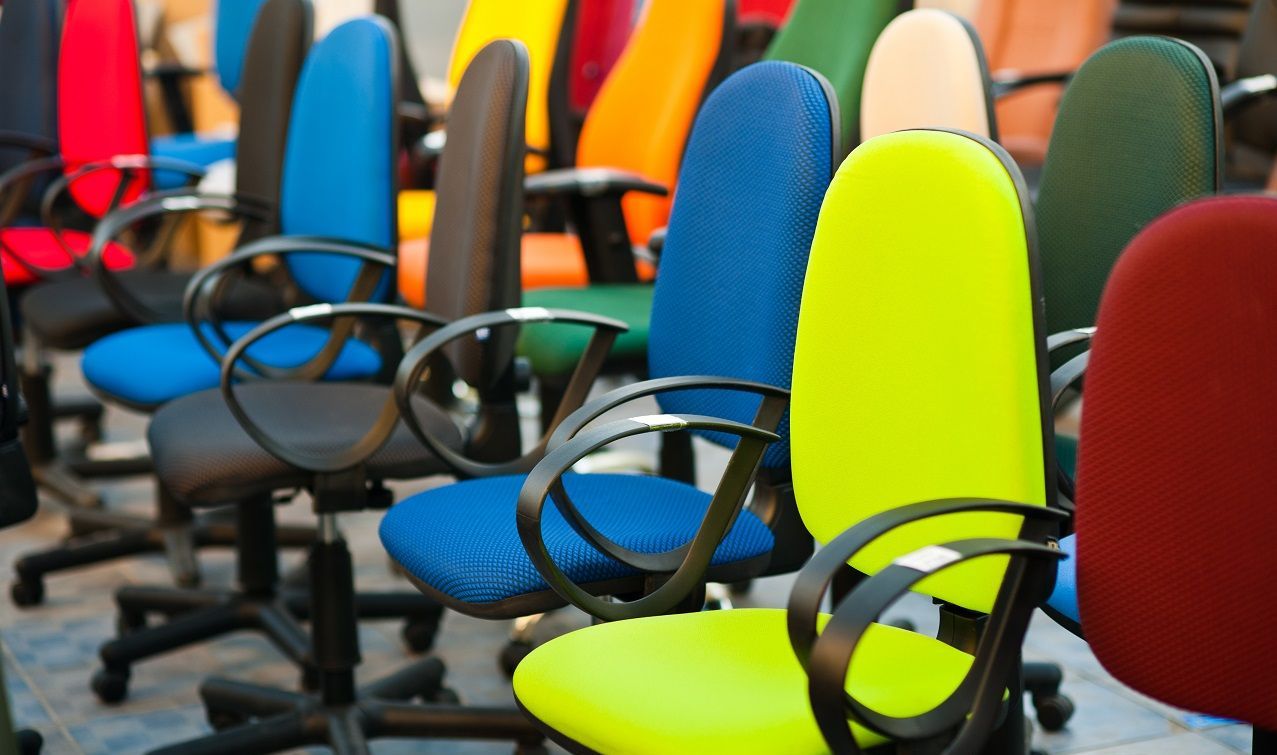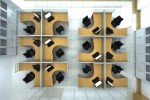According to a study by Juststand.org, roughly 86% of Americans sit during their work day. Add to that the leisure time spent watching TV, browsing the internet or reading, and U.S. adults end up sitting an average of 13 hours a day. This sedentary lifestyle comes with a plethora of health risks for workers, from back pain and poor blood circulation, to posture problems and weakened muscles.
Many companies are now encouraging their workers to stretch their legs, pepper their working day with short walks and ride a bike to work. Alongside these measures, they are also looking for increasingly ergonomic, practical, stylish and environmentally-friendly furnishing solutions for their offices. Today, creating office furniture is about more than making a comfy chair (although it’s a good start!). Designers know that every detail―from the choice of materials, to the color palette they use―can make a difference in creating an atmosphere that will increase worker productivity and wellbeing. Here is a list of some of the most interesting companies you can work with as you’re planning for that office makeover.
Herman Miller
The story of this iconic American brand begins with Herman Miller, a Michigan business man who in 1923 decided to help his son-in-law, D.J. De Pree, acquire the Michigan Star Furniture Company. De Pree went on to name the company in Miller’s honor, attracting some of the top talent in industrial design, with icons like George Nelson and Charles and Ray Eames creating many of Herman Miller’s most recognizable and popular pieces. Other noteworthy collaborations over the years include designs by Isamu Noguchi, Yves Béhar, Don Chadwick, Bill Stumpf, Alexander Girard, Robert Propst, Ayse Birsel and Doug Ball.
Although currently roughly 70% of U.S. offices have an open plan layout, Herman Miller is credited with the creation of another famous office design: the cubicle. When the company released the Action Office II, landlords and company executives were quick to catch on to the benefits of this layout. Unfortunately, unlike the exemplary design of Herman Miller cubicles―which offered workers flexible, customizable work space with easy access for communication and privacy for individual tasks―copies of this original idea ended up giving the cubicle a bad rap with both employees and employers.
The Aeron chair, a popular Herman Miller product, first designed in 1994 by Bill Stumpf and Don Chadwick and revamped in 2016, was dubbed America’s best-selling chair by Bloomberg and is part of the Museum of Modern Art’s permanent collection.
The Noguchi Table was created by American-Japanese sculptor Isamu Noguchi under the belief that “everything is sculpture”, regardless of material or use. The original model featured a base produced in birch, walnut and cherry, going through different variations over the years. The current series allows clients to choose between an ebonized, walnut, white ash or natural cherry finish.
Over 500 people working at Herman Miller are involved in environmental initiatives that seek to render the company’s output as ecologically sound as possible, by focusing on using recycled and recyclable materials, and achieving sustainability through ecodesign and energy efficient manufacturing.
Uhuru
When you get people from all over the world reaching out to you because they’ve heard that Uhuru is the place that makes sleek, modern furniture out of weird or unusual materials, it’s clear that innovation is a key value of your company. Based in Red Hook , Brooklyn, the firm was founded by two Rhode Island School of Design graduates, Jason Horvath and Bill Hilgendorf, in 2004. Since then, they’ve built an additional 45,000-square-foot facility near Lancaster, Penn. and set up international production in Vietnam.
Uhuru has made a name for itself by producing hand-crafted furniture, using reclaimed materials and wood from the Coney Island boardwalk and Kentucky bourbon distilleries, salvaged wood from abandoned barns in Pennsylvania or collapsing cabins in Ukraine. The company’s eco-friendly ethos might have been rooted in the necessities and limitations of its earlier days as well as its approaches to weathering the rough business environment following the financial crisis, but today it has been embraced wholeheartedly as the key to sustainable design.
Sitting long hours in front of a screen leads many office workers to complain about lower back and neck pain. To address this issue, Uhuru has designed the Minim Rise Line, a SIT|STAND workstation which has both a fixed height and an adjustable component with a state-of-the-art electronic lift system, complimented by a range of work surface options. The standing desk moves between 27-47 inches and allows for power plugs, USB, HDMI and data slots.
For those looking for more storage solutions for their office, Uhuru’s Totem Storage Line might be the perfect fit. Storage units come in six different colors―including daring options like oxblood and mint green―and boast a modular and stackable system that pays tribute to famous minimalist sculptors and the company’s Brooklyn roots.
Poppin
Poppin’s “work happy” is not just an upbeat company motto. It reflects a deep commitment to a feature that often plays second fiddle in the grand scheme of office design: color. The New York-based designer is serious about standardizing its color palette across its array of products. No mean feat, given how color is absorbed differently by materials such as plastic, cardboard, metal or rubber. Poppin has invested in color matching software for its production facilities to better control and adjust color variations before each product is shipped. It also introduces new colors to its core palette every six months and works alongside fashion designers to gauge the latest pattern trends in order to expand design and customization options for its clients.
Poppin makes everything, from vibrant stationery items to endlessly versatile office furniture, like their Series A Ping-Pong Conference Table, which can be assembled or adapted to a different configuration entirely tool-free. Need a solution for employees complaining about high noise levels affecting their work? Poppin designed the QT Privacy Lounge Chair, padded with sound absorbing materials, which provides workers with much-needed privacy, helping them focus on the task at hand.
Join the likes of LinkedIn, Squarespace, Kate Spade, Shutterfly and 20,000 other businesses that have worked with Poppin to create a friendlier, more vibrant workplace. Pay a visit to their showrooms in New York, San Francisco, Santa Monica and their upcoming Boston location.
Clear Design
Initially founded in 1982 in the U.K., Clear Design opened its USA operations in San Antonio, Texas in 2003, becoming since then a formidable open-plan expert. Their BLADE system can be used in various settings, such as conference rooms, call centers, training rooms and executive offices. It consists of a beam structure that can be extended and linked with similar structures to increase office layout options.
Companies opting for the BLADE system for their open plan offices can look forward to receiving some good news. In terms of cost effectiveness, Clear Design estimates a 15-40% gain over traditional cubicles, with an additional 22-26% savings on real-estate costs, due to the better use of available space.
Flexibility is a key component in today’s business environment, where many startups are expanding at a rapid pace and need to adapt their offices for a growing workforce. Using locking, expandable beams, the BLADE system offers maximum re-configurability.
And you won’t have to worry about eco-friendly furniture, as nothing is greener than re-usable furniture. You can disassemble and integrate Clear Design units in infinite configurations, turning workstations into conference room tables in a few easy steps. The company also uses FSC-certified and CARB Phase 2 compliant work surfaces, manufactured in the U.S.
MASHstudios
When you visit MASHstudios’ website, you won’t find a catalogue of their most popular furniture items, because with this firm, no two commission are the same and no two designs are alike. When founder Bernard Brucha launched MASHstudios in 2002, he set out to create sustainable, unique pieces of office furniture than would change the workplace for the better. Since then, the Los Angeles-based company has added names like MTV, Microsoft, Facebook, eBay, Twitter and Gensler to its client roster.
The studio’s services can also be secured through some of their other showrooms across the U.S., in New York, New Jersey, Connecticut, and internationally, in Tokyo.
Some of its most remarkable projects include work done for Yelp’s headquarters, at 140 New Montgomery in San Francisco’s Financial District. Yelp wanted a design that would pay tribute to the grace and elegance of its new home in the 1920s Art Deco building, so MASHstudios lined the entrance to the café with a row of birch and white laminate LAXseries benches and custom panel tables with exposed steel bases and wood edges.
MASHstudios worked alongside Huntsman Architecture, to create an environment for Lithium’s communal culture. A white matte Color Core laminate desk with I-shaped privacy panels stands as the reception desk at Lithium’s headquarters and the office also sports a large, natural walnut worktable.









